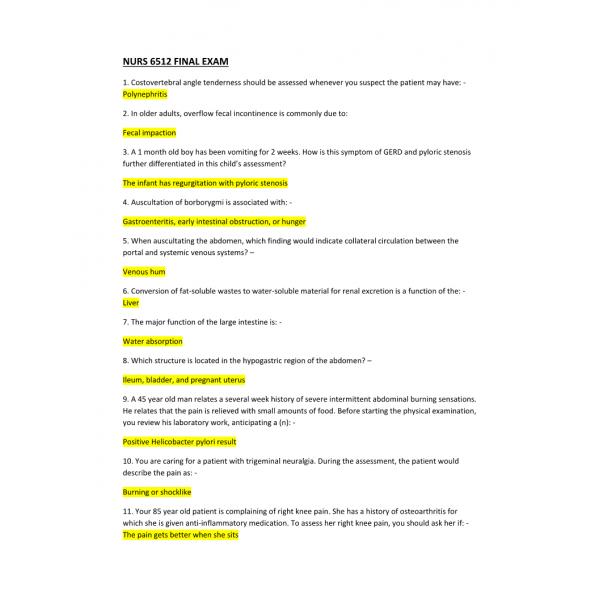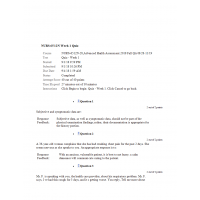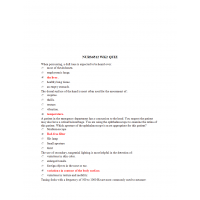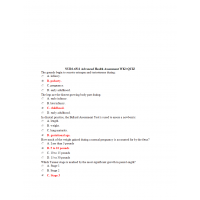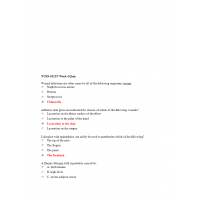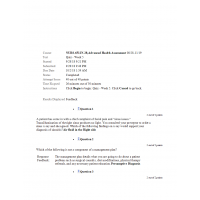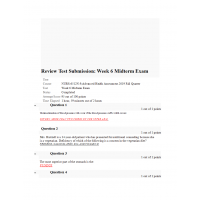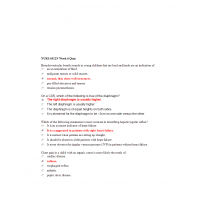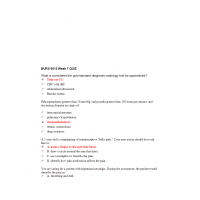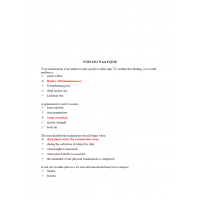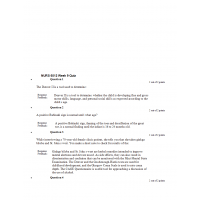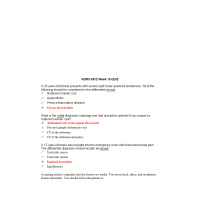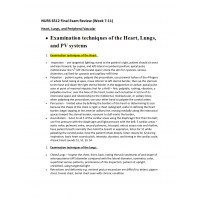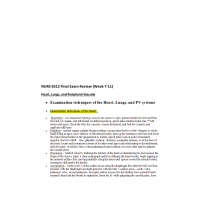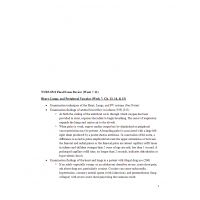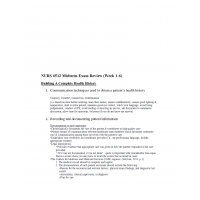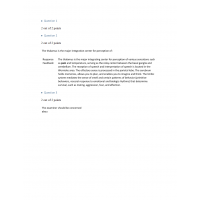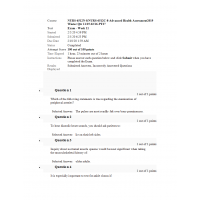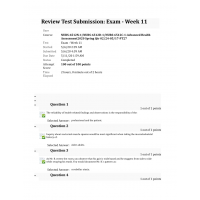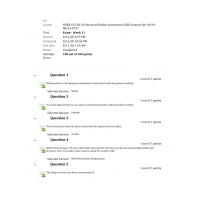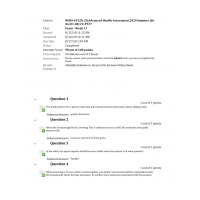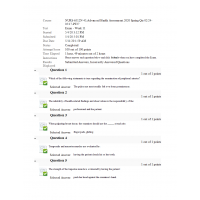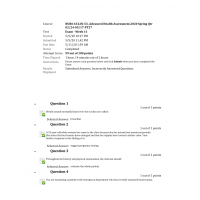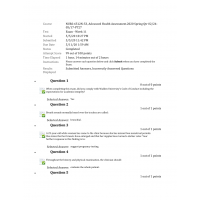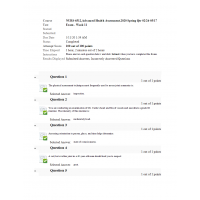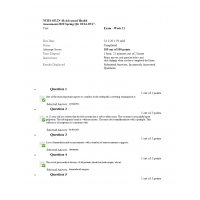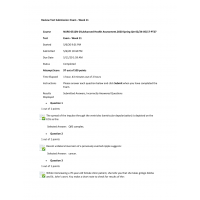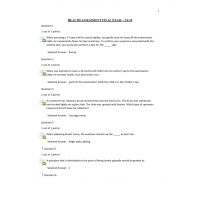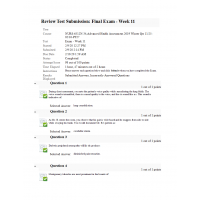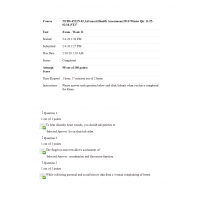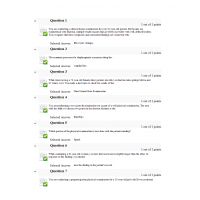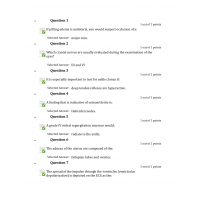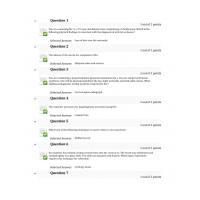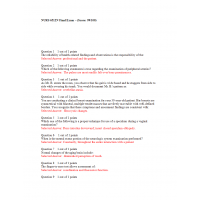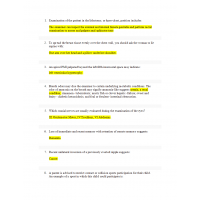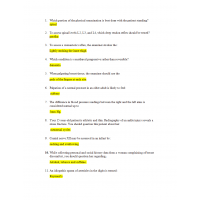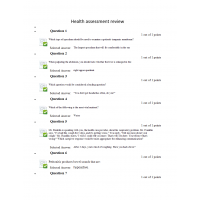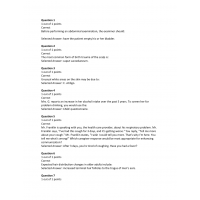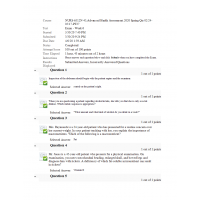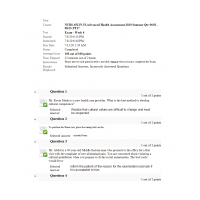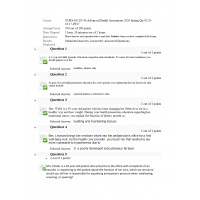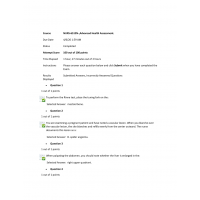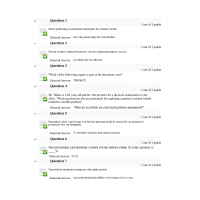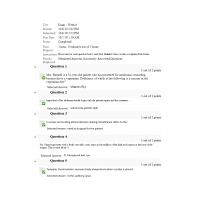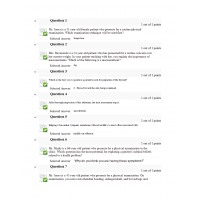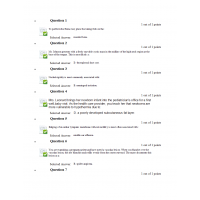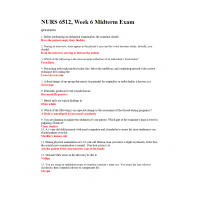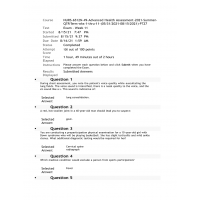NURS 6512 Final Exam 2019
1. Costovertebral angle tenderness should be assessed whenever you suspect the patient may have: -
2. In older adults, overflow fecal incontinence is commonly due to
3. A 1-month-old boy has been vomiting for 2 weeks. How is this symptom of GERD and pyloric stenosis further differentiated in this child’s assessment?
4. Auscultation of borborygmi is associated with
5. When auscultating the abdomen, which finding would indicate collateral circulation between the portal and systemic venous systems?
6. Conversion of fat-soluble wastes to water-soluble material for renal excretion is a function of the
7. The major function of the large intestine is
8. Which structure is located in the hypogastric region of the abdomen?
9. A 45-year-old man relates a several week history of severe intermittent abdominal burning sensations. He relates that the pain is relieved with small amounts of food. Before starting the physical examination, you review his laboratory work, anticipating a (n)
10. You are caring for a patient with trigeminal neuralgia. During the assessment, the patient would describe the pain as
11. Your 85 year old patient is complaining of right knee pain. She has a history of osteoarthritis for which she is given anti-inflammatory medication. To assess her right knee pain, you should ask her if
12. A 5 year old is complaining of nondescriptive “belly pain.” Your next action should be to ask him to: -
13. The perception of pain
14. Patients presenting with ascites, jaundice, cutaneous spider veins, and nonpalpable liver exhibit signs of
15. A patient presents to the emergency department after a motor vehicle accident. The patient sustained blunt trauma to the abdomen and complains of pain in the upper left quadrant that radiates to the left shoulder. What organ is most likely injured?
16. Imaging studies reveal that a patient has dilation of the renal pelvis from an obstruction in the ureter, what condition will be documented in this patient’s health record?
17. Visible intestinal peristalsis may indicate
18. Infants born weighing less than 1500g are at higher risk for
19. Which of the following factors is not known to affect patient compliance with his or her treatment regimen?
20. One of the most important aspects to consider in the orthopedic screening examination is
21. The sequence of the physical examination should be individualized to
22. As you greet the patient, which examination technique is first implemented?
23. Which of the following is most likely to enhance examiner reliability?
24. A 7 year old boy is brought to your office with a chief complaint of possible fracture to his left third finger. He jammed it while playing basketball 2 days ago. The mother states that she really does not think it is broken because he can move it. What is your best response?
25. A patient presenting for the first time with typical low back pain should receive which of the following diagnostic tests?
26. Skeletal changes in older adults are the result of
27. A positive straight leg raise test usually indicates
28. What technique is performed at every infant examination during the first year of life to detect hipdislocation?
29. Expected normal findings during inspection of spinal alignment include
30. Temporalis and masseter muscles are evaluated by
31. When palpating joints, crepitus may be caused when
32. A 3 year old is brought to the clinic complaining of a painful right elbow. He is holding the right arm slightly flexed and pronated and refuses to move it. the mother states that symptoms started right after his older brother had been swinging him around by his arms. This presentation supports a diagnosis of
33. Light skin and thin body habitus are risk factors for
34. Risk factors for sports-related injuries include
35. Injuries to long bones and joints are more likely to result in fractures than in sprains until
36. Ligaments are stronger than bone until
37. The family history for a patient with joint pain should include information about siblings with
38. The Thomas test is used to detect:
39. A goniometer is used to assess
40. During a football game, a player was struck on the lateral side of the left leg while his feet were firmly planted. He is complaining of left knee pain. To examine the left knee you should initially perform the ________ test.
41. You note that a child has a positive Gower Sign. You know that this indicates generalized
42. The dowager hump is
43. What temporary disorder may be experienced by pregnant women during the third trimester because of fluid retention?
44. A common finding in markedly obese and pregnant women is
45. A 45-year-old laborer presents with low back pain, stating that the pain comes from the right buttock and shoots down and across the right anterior thigh, down the shin to the ankle. Which examination finding is considered more indicative of nerve root compression?A 45 year old laborer presents with low back pain, stating that the pain comes from the right buttock and shoots down and across the right anterior thigh, down the shin to the ankle. Which examination finding is considered more indicative of nerve root compression?
46. Mrs. Bower is a 57 year old patient who comes in for an office visit. Which of the following disorders is known to be hereditary?
47. Testing of cranial nerve ________ is not routinely performed unless a problem is suspected.
48. The patient is able to rapidly touch each finger to his thumb in rapid sequence. What does this finding mean?
49. Which question asked by the examiner may hellp to determine prevention strategies for seizures that a patient is experiencing? –
50. A patient has a complaint of dizziness. The patient makes the following statement: “I sometimes feel as if the whole room is spinning.” What type of neurologic dysfunction should the examiner suspect?
51. The examiner asks the patient to close her eyes, then places a vibrating tuning fork on the patient’s ankle and asks her to indicate what is felt. What is being assessed?
52. Which of the following findings should an examiner consider a normal finding if associated with pregnancy?
52. Jack is a 52 year old obese man with a history of poorly controlled diabetes. He also smokes. Based on the above data, the examiner should recognize that Jack has several risk factors for
53. Mrs. Jones is a 24 year old patient who presents to your office 2 days postpartum. She complains that she is experiencing foot drop. Which of the following problems should the examiner consider?
54. The examiner is assessing deep tendon reflex response in a 12 year old boy. The response is an expected reflex response. Which of the following scores should be documented?
55. A 68 year old patient presents to your office for follow-up. He tells you, “I have a hard time finding the right words when I am talking;” he also is experiencing numbness. On examination, you note postural instability. This symptom may be
56. Motor maturation proceeds in an orderly progression from
57. The thalamus is the major integration center for perception of
58. The examiner should be concerned about neurologic competence if a social smile cannot be elicited by the time a child is ________old
59. Normal changes of the aging brain include
60. When interviewing a 70 year old female clinic patient, she tells you that she takes ginkgo biloba and St. John’s Wort. You make a short note to check for results of the
61. The area of body surface innervated by a particular spinal nerve is called a
62. If a patient cannot shrug the shoulders against resistance, which cranial nerve (CN) requires further evaluation?
63. The finger-to-nose test allows assessment of
64. You ask the patient to follow a series of short commands to assess
65. As Mr. B. enters the room, you observe that his gait is wide based and he staggers from side to side while swaying his trunk. You would document Mr. B.’s pattern as
66. When is the mental status portion of the neurologic system examination performed?
67. An aversion to touch or being held, along with delayed or absent language development, is a characteristic of
68. The autonomic nervous system coordinates which of the following?
69. The major function of the sympathetic nervous system is to
70. The parasympathetic nervous system maintains the day-to-day function of
71. Cerebrospinal fluid serves as a
72. You are performing a two-point discrimination test as part of a well physical examination. The area with the ability to discern two points in the shortest distance is the
73. Which type of hallucination is most commonly associated with alcohol withdrawal?
74. On a scale of 0 to 4+, which deep tendon reflex score is appropriate for a finding of clonus in a patient?
75. Which statement is true regarding mental status changes in older adults?
76. A characteristic related to syphilis or diabetic neuropathy is testicular
77. When collecting personal and social history data from a woman complaining of breast discomfort, you should question her regarding
78. What risk factor is associated with cervical cancer?
79. A 23 year old female presents with severe right lower quadrant tenderness. All of the following should be considered in the differential except
80. What is the initial diagnostic radiology test that should be ordered if you suspect a ruptured ovarian cyst?
81. A 17 year old male was brought into the emergency room with testicular/scrotal pain. The differential diagnosis should include all except
82. The nursing mother complains that her breasts are tender. You assess hard, shiny, and erythremicbreasts bilaterally. You should advise the patient to
83. A normal vas deferens should feel
84. In a woman complaining of a breast lump, it is most important to ask about
85. The finding of a painless indurated lesion on the glans penis is most consistent with
86. Thrombosed hemorrhoids are
87. Pregnancy-related cervical changes include
88. You are inspecting the genitalia of an uncircumcised adult male. The foreskin is tight and cannot be easily retracted. You should
89. An adolescent male is being seen for acute onset of left testicular pain. The pain started 3 hours ago. He complains of nausea and denies dysuria or fever. Your prioritized assessment should be to
90. A 23-year-old white woman has come to the clinic because she has missed two menstrual periods. She states that her breasts have enlarged and that her nipples have turned a darker color. Your further response to this finding is
91. What accommodations should be used in the position of a hearing-impaired woman for a pelvic examination?
92. Sexual differentiation in the fetus has occurred by _______weeks gestation.
93. You are performing a clinical breast examination for a 55-year-old woman. While palpating the supraclavicular area, you suspect that you felt a node. In order to improve your hooked technique, you should
94. If a firm, transverse ridge of compressed tissue is felt bilaterally along the lower edge of a 40-year-old patient’s breast, you should
95. A therapeutic technique for dealing with grieving individuals is to
96. The examination of the newborn should begin with
97. Which one of the following patient characteristics is most likely to limit patient reliability during history taking?
98. In crying infants, it is often difficult to
99. Which of the following statements accurately reflects the sensitivity and specificity of laboratory tests?
100. Which medical condition would exclude one from sports participation?
101. Your 15-year-old patient is athletic and thin. Radiography of an ankle injury reveals a stress fracture. You question this patient about her
102. Which of the following are examined with the patient in a reclining 45-degree position?
103. Functional assessment is most important during the examination of a(n)
104. The best way to ease the apprehension of a 3-year-old child before a physical examination is to
105. An ophthalmoscopic eye examination involves
106. When conducting a geriatric assessment, basic activities of daily living (ADLs) include
107. The checkout station for preparticipation physical evaluation (PPE) is critical because at this point
108. Which of the following is true regarding the relationship between the examiner and the patient? 109. Which of the following factors is not known to affect patient compliance with his or her treatment regimen?
110. One of the most important aspects to consider in the orthopedic screening examination is
111. As you greet the patient, which examination technique is first implemented?
112. Which portion of the physical examination is best done with the patient standing?
113. Which patient position facilitates inspection of the chest and shoulders?
114. The least reliable indicator of newborn distress is
115. Proprioception should be assessed while the patient is
116. Part of the screening orthopedic component of the examination includes evaluating the person while
| Institution & Term/Date | |
| Term/Date | Walden University |
NURS 6512N Final Exam 19 - Question and Answers
- Product Code: 2020
- Availability: In Stock
-
$35.00
Related Products
Tags: NURS 6512N

